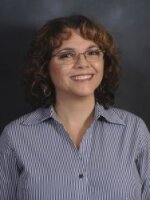For the past year, the University of West Florida Archaeology Institute has taken the lead on a grant project entitled By These Hands: The Vernacular Markers of Pensacola’s Historic African American Cemeteries.
The information collected is being used to weave together previously untold stories of the burial grounds and the people in them.
The project originated with John the Baptist Church, the oldest African American Church in Pensacola, dating back to 1846. The church sought to focus attention on their historic Montgomery Cemetery located at 8th Avenue and Cross Street.
“They applied for a grant from the Florida Humanities Council, not only to look at the vernacular markers not only in their cemetery, but in cemeteries around town, around Pensacola,” said UWF archaeologist Margo Stringfield, who is coordinating the university’s involvement with the project.
Stringfield is known for her extensive research, restoration and preservation efforts at Pensacola’s Historic St. Michael’s Cemetery, which was established in the 1780’s and is one of the oldest cemeteries in Florida.
Many of the grave sites at St. Michael's reflect a specific architectural design, very formal in style and material such as marble and granite. Stringfield says this African American cemetery project involves grave markers that are totally different.
“When you use the word vernacular marker, what you’re seeing is a marker that is typically handmade,” Stringfield said. “It’s made certainly by an artisan craftsman, but it’s one that really expresses more a local mindset. It’s using locally available materials. It’s reflecting what is going on in the community.”
Looking specifically at John the Baptist, the church acquired the land for its Montgomery Cemetery in the late 1800’s, about the same timeframe as Pensacola’s Magnolia and AME Zion cemeteries. Stringfield says the markers at these burial grounds often reveal a more vivid story about the people they denote than can be found anywhere else.

“At John the Baptist cemetery, their person most people would be familiar with is Spencer Bibbs,” said Stringfield.
Bibbs was born in Montgomery, AL in 1859 and - at the age of 13 - moved to Pensacola, where he died in 1922.
Bibbs worked as a driver and held other jobs. But, he’s most noted for his service as the first black supervisor of colored schools in Pensacola. An elementary school, now the Spencer Bibbs Center, was named in his honor. It's located at 2005 N 6th Avenue.
“His site (marker) in John the Baptist was likely made by the same artisan that was making markers that we’re seeing over at Magnolia and AME Zion,” said Stringfield. “And, we’re hoping to be able to identify the maker of these markers. This is someone that was making markers between about 1902 and 1924.”
Also, there are several less known people in the cemetery, such as Mrs. Mariah McQueen, whose family members in Tennessee have provided more information about her, excited to now know where she’s buried. Also buried there is Ebbie Grier, who's a member of the family that ran the long-standing H & O Café in Pensacola.
“What you’re seeing in these cemeteries is a connection between people and food; you’re seeing on every level cultural interaction within the community.”
This project has been a community effort. It was born out of the work of the Pensacola Area Cemeteries Team (PACT) Initiative. And, it includes the involvement of the Florida Public Archaeology Network, John the Baptist Church, and numerous students and staff from the University of West Florida.
UWF history students are researching the people at Montgomery Cemetery.
Science is happening there, too.

UWF students and faculty have used a 3-D scanner at Spencer Bibbs’ marker. Additionally, a senior chemistry student has been analyzing the cement overcoat, as well as the interior construction concrete mix that was used at the Bibbs site and other sites, such as Magnolia and AME Zion to determine if they’re from the same source material.
To learn about the project and the research at the Bibbs’ site, people can link to the UWF Division of Anthropology and Archaeology blog Vertibra.
It’s this kind of work that is required for the “By These Hands” grant project, which is focused primarily on providing interpretive materials.
For example, an interpretative kiosk at the Montgomery-John the Baptist Cemetery will be unveiled Saturday, September 19.
Also, the project will include a dedicated website.
And, a major part of the project is a three-day Public Workshop taking place this week, with most events Saturday at John the Baptist Church, 101 N 10th Avenue. It includes an extensive series of preservation activities, cemetery tours, and talks highlighted by representatives from the National Park Service. They’ll discuss the importance of preserving old African American cemeteries.
“The cemeteries themselves are fragile in many ways,” Stringfield said, noting that the project is really telling an untold story about our community. “And, it’s going to be a wonderful story that adds to our understanding of who we are as Pensacolians, Floridians, and Americans.”
The By These Hands workshop kicks off this Thursday (Sept. 17) evening with a talk by National Park Service Historian Dennis Montagna. His presentation focusing on the “The African Burial Ground National Monument” in New York will begin at 6:30 p.m. at the West Florida Public Library Main Branch, 239 N Spring Street. Refreshments will be served at 6:00 p.m.






